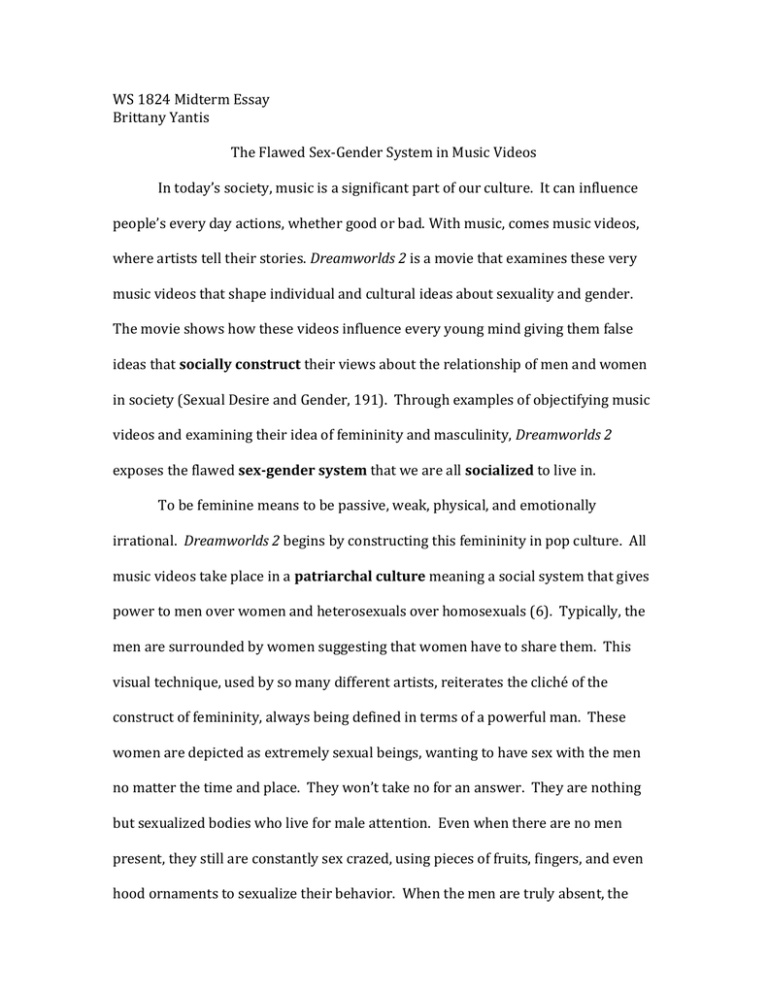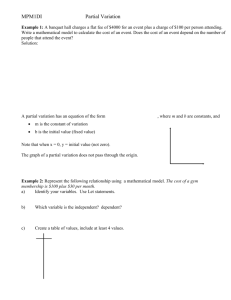
WS 1824 Midterm Essay
Brittany Yantis
The Flawed Sex-Gender System in Music Videos
In today’s society, music is a significant part of our culture. It can influence
people’s every day actions, whether good or bad. With music, comes music videos,
where artists tell their stories. Dreamworlds 2 is a movie that examines these very
music videos that shape individual and cultural ideas about sexuality and gender.
The movie shows how these videos influence every young mind giving them false
ideas that socially construct their views about the relationship of men and women
in society (Sexual Desire and Gender, 191). Through examples of objectifying music
videos and examining their idea of femininity and masculinity, Dreamworlds 2
exposes the flawed sex-gender system that we are all socialized to live in.
To be feminine means to be passive, weak, physical, and emotionally
irrational. Dreamworlds 2 begins by constructing this femininity in pop culture. All
music videos take place in a patriarchal culture meaning a social system that gives
power to men over women and heterosexuals over homosexuals (6). Typically, the
men are surrounded by women suggesting that women have to share them. This
visual technique, used by so many different artists, reiterates the cliché of the
construct of femininity, always being defined in terms of a powerful man. These
women are depicted as extremely sexual beings, wanting to have sex with the men
no matter the time and place. They won’t take no for an answer. They are nothing
but sexualized bodies who live for male attention. Even when there are no men
present, they still are constantly sex crazed, using pieces of fruits, fingers, and even
hood ornaments to sexualize their behavior. When the men are truly absent, the
women fall apart emotionally, often seen crying in a bathroom or moping on a bed.
When not shown partying poolside or at a club, the women are doing things for men,
such as seductively washing their cars. When the women are actually shown in
professions, they are shown in the typical feminine ones. Whether nurses, flight
attendants, cheerleaders, sorority girls, hotel maids, librarians or schoolteachers,
they always are dressed for the men. Music videos create a very unique construct of
femininity that conforms to our androcentric society without attempting to
challenge it (1). The major problem is that women are being depicted as nothing
else in these videos. If traits such as intellectual, spiritual, athletic, creative,
occupational, and independent were displayed as well it would be okay for a little
objectification. But this is the only way femininity is being thought of, that women
are only here to please men. Their bodies are being fabricated by a male
dominated culture reinforced by a multi-billion dollar industry (music) (223).
The objectification of women’s bodies is constantly upheld by media and
entertainment industries (225). Even female artists, who hope to challenge these
views, eventually learn to conform to it. They have to fit into an existing set of
stories by presenting themselves as primarily sexual beings. Recently, Beyonce’s
“Run the World,” a song attempting to empower girls to believe that they can do
anything they set their mind to, even run the world, seemed to be challenging these
views. However, when I watched the music video, the women were still shown as
sexual beings, fawning all over the men. The pressures to conform to this are
relentless and women quickly become wedded into the pornographic dream world
of men.
To be masculine means to be aggressive, strong, a leader, rational, and
intellectual. As with femininity, Dreamworlds 2 depicts this masculinity in particular
with the idea of control. Men in these videos are obsessed with power, intimidation,
and force. Men are sometimes seen as stalking or attacking women, yet the women
never seem to fight back. Males feel they are entitled to do whatever they want to
men. Women are pushed against walls, knocked down, slapped, and spanked. They
want to have control over women and even when women try to resist them, they
eventually give in.
The videos don’t stop there in these ideas of femininity, and masculinity, they
throw in a few racial constructs as well. The idea of whiteness and blackness is
strongly depicted in music videos, as it is typically white men who control media
empires, Phillipe Dauman, the head of MTV, is a white male. As discussed in class,
whiteness is seen as honest, hardworking, and moral. Blackness however is seen as
just the opposite, dishonest, lazy, abnormal, immoral, and criminal. In music videos
black men are shown as the attackers and rapists of white women. They are the bad
guys. African American women, however, have recently become able to enter the
music video industry, but at a high price. They are only being shown for the one
part of their bodies that men enjoy, their buttocks. The music industry is a white
supremacist capitalist heteropatriarchy (Feminist Politics, 42), meaning it
typically places whites over blacks. It constantly is enforces a dichotomous type of
thinking; where white and black are polar opposites, white being good, black being
evil (Toward a New Vision, 79).
Patricia Hill Collins says “whether we benefit or not, we all live within
institutions that reproduce race, class, and gender oppression. Even if we never
have any contact with members of other race, class and gender groups, we all
encounter images of these groups and are exposed to the symbolic meanings
attached to those images” (Toward a New Vision, 1993). These music videos are
doing just that. In society, everyone’s behavior is based upon assumptions and
values of the culture. However, when pop culture and music videos are encouraging
all of this, it makes people believe its okay to act this way in reality. Today, so many
young children watch music videos; the average child watches about 3-4 hours of TV
each day. Now with things like YouTube, it is even easier to watch music videos.
The stories being told of the roles men and women should play become firmly
implicated with the gender and power relations of our society. We are becoming
socially constructed to conform to these values and it becomes normativity. It
becomes the only thing they know and they start to believe that that is how it should
be. Today, boys and men rape women in the U.S. every two minutes. On college
campuses, 90% of rape victims know their attackers. These statistics show that so
many people are affected by these ideals given to us from music videos and how the
line between fantasy and reality can become easily blurred.
In this society, we are all given a social identity that we are supposed to
adhere to. Girls face a struggle when it comes to this. They receive something called
the virgin/whore dichotomous type of thinking when it comes to how they
should act (Oppression, 85). If they are having sex, they are considered whores,
because other people see the women in these music videos acting sexual leading to
the idea that they are whores. However, if they aren’t being sexual like these
women, they are prude virgins, which also gets a negative connotation. Men face
similar struggles when told they have to be super masculine with girls fawning all
over them, like in the videos, or they might be seen as weak, or even gay. White
people have to be perfect citizens, hardworking, honest, and moral whereas blacks
have to be just the opposite, criminal, dishonest, and foreign. Culture teaches us
how to be men and women. Pop culture feeds into this flawed system of social
identities. After seeing this video, people need to realize how absurd the identities
they teach us are and they need to be challenged. Nikki Giovanni is quotes in the
reading “Toward a New Vision” saying, “we’ve got to live in the real world. If we
don’t like the world we’re living in, change it. We can do something” (80).
Works Cited
Dreamworlds II: Desire, Sex, Power in Music Video. Dir. Sut Jhally. 1997.
Videocassette.
Shaw, Susan M., and Janet Lee. Women's Voices, Feminist Visions: Classic and
Contemporary Readings. Boston: McGraw-Hill Higher Education, 2009.





